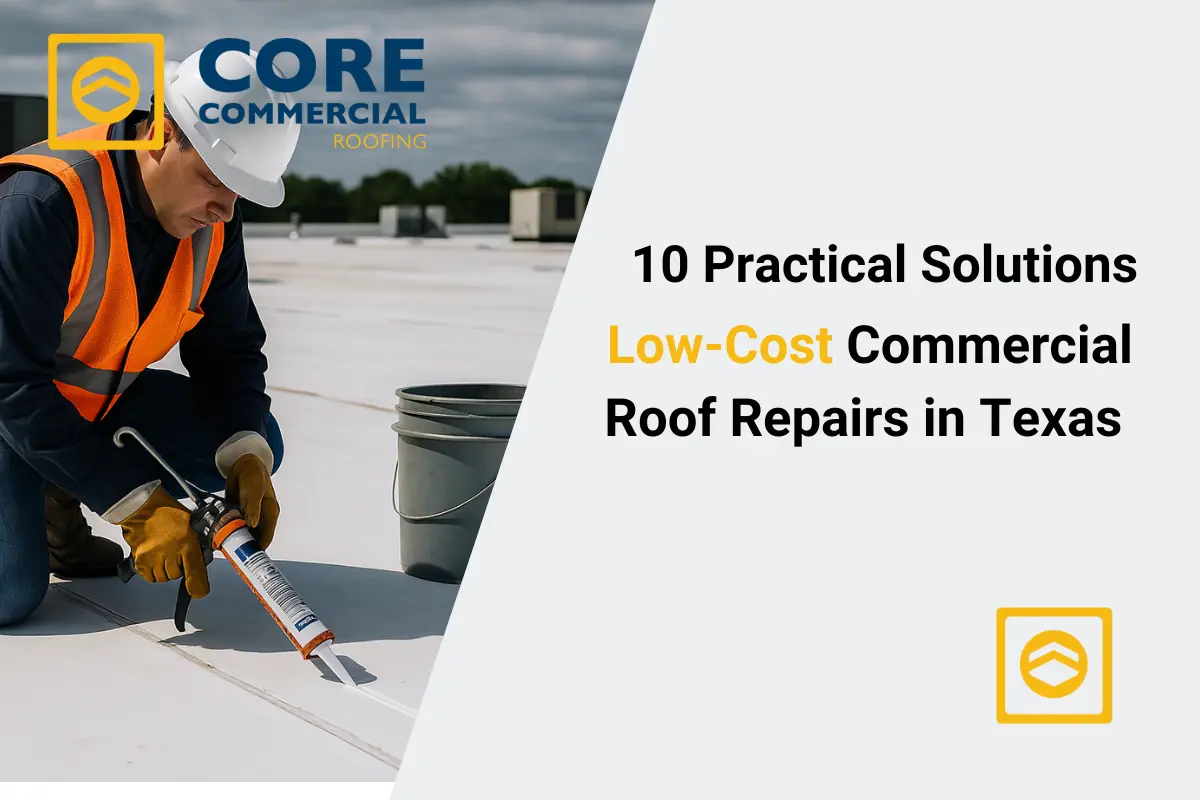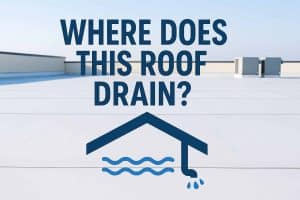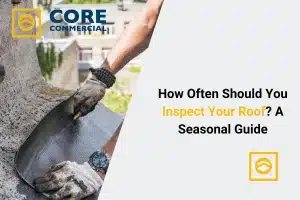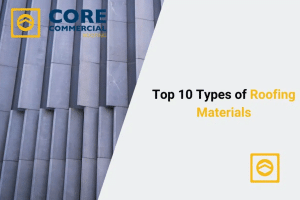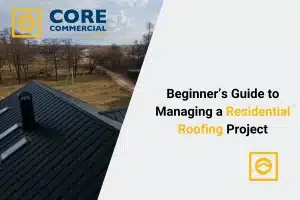If you own or manage a commercial property. You already understand how brutal weather, scorching sun, high winds, and sudden hailstorms can take a serious toll on your roof. When problems arise, fast and affordable solutions are critical to keep your business running and your property protected. But here’s the good news: commercial roof repairs don’t have to be overwhelming or expensive.
Whether you’re dealing with minor leaks, energy inefficiencies, or storm damage, there are practical and cost-effective ways to extend the life of your roof without blowing your budget. Below, we’ll walk you through 10 smart repair strategies used by savvy property owners across the region to reduce costs, minimize disruptions, and protect your investment.
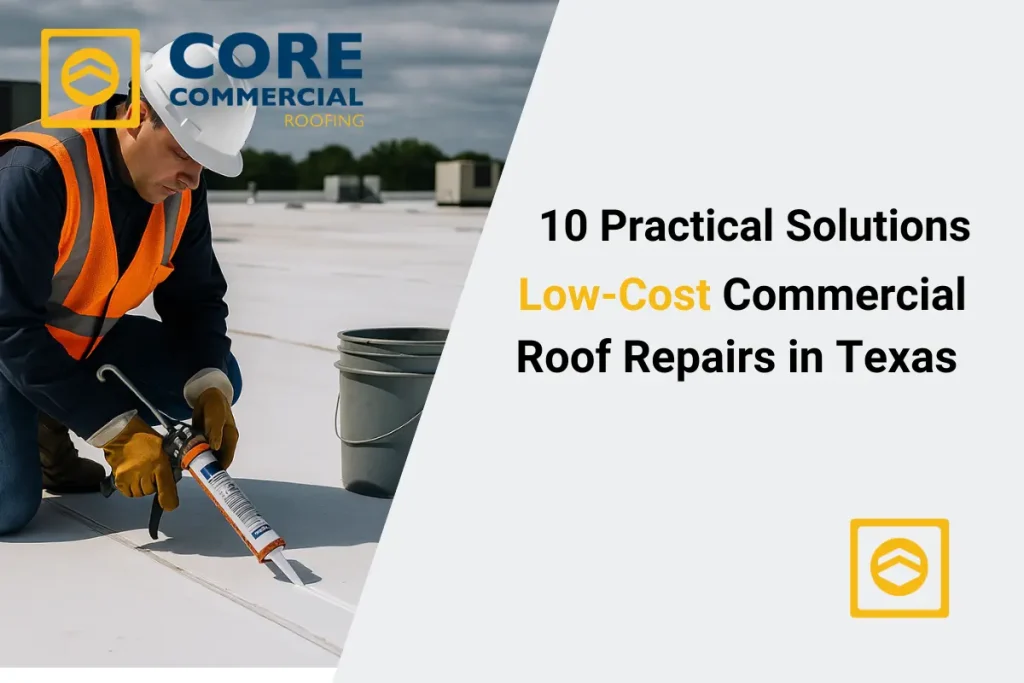
Table of Contents
Understand the Real Cost of Waiting
Postponing roof repairs is one of the most expensive mistakes a property owner can make. A small leak may seem harmless today, but it can quickly spiral into structural damage, mold issues, and lost business days.
What you risk by waiting:
- Repair costs that snowball
- Insurance denials due to neglect
- Business downtime from sudden replacements
Early action protects your building and saves you money long-term.
Identify Common Commercial Roofing Problems
Roofs in this region face intense UV exposure, seasonal hail, and heavy winds. The most common problems include:
- Cracked membranes
- Ponding water on flat surfaces
- UV and heat degradation
- Torn seams and wind uplift
- Clogged or broken drainage systems
Recognizing these issues early gives you a better chance at solving them affordably.

1: Start with a Low-Cost Roof Inspection
Before making any repairs, get a clear picture of your roof’s condition. Many professional contractors offer free or low-cost inspections, especially after storms.
Why it matters:
- Identifies urgent vs. non-urgent issues
- Helps you avoid unnecessary replacements
- Creates documentation for insurance or tax purposes
Choose licensed local contractors familiar with Texas weather conditions and codes.
2: Prioritize Minor Repairs Before They Become Major
Tackling small issues now can prevent major costs later. Fixing one seam or patch today might save you from replacing an entire section tomorrow.
What to look for:
- Water stains on ceiling tiles
- Small cracks or blisters in the roof membrane
- Rust around roof penetrations
Act fast and document everything for warranty protection.
3: Use Reflective Roof Coatings for Cost-Efficient Protection
These coatings reflect sunlight and significantly lower surface temperatures. They also extend the life of your existing roofing system.
Key benefits:
- Reduces heat absorption by up to 50°F
- Cuts cooling costs
- Seals minor cracks and UV damage
Popular choices include acrylic (affordable), silicone (waterproof), and elastomeric (flexible and durable).
4. Choose Targeted Repairs Over Full Replacement
A full roof replacement isn’t always necessary. You can often save thousands by only repairing the damaged sections.
Examples of targeted fixes:
- Resealing lifted seams
- Reinforcing flashings
- Replacing damaged membrane panels
Only consider a full replacement if damage covers more than 25% of the roof or if systems are failing across the board.
5. Patch Leaks Using Quick-Cure Sealants
After a storm, a fast solution is critical. Quick-cure sealants can stop leaks immediately and prevent further water intrusion.
Best for:
- Skylight edges and flashing
- Temporary emergency fixes
- Sealing seams or roof vents
Keep a roofing-grade sealant kit onsite for emergencies.
6: Reinforce High-Wear Areas with Membrane Patches
Foot traffic near HVAC systems, drains, or vents can wear down the roof surface quickly.
Budget-friendly fix:
- Apply membrane patches or peel-and-stick kits
- Use roofing primers for better adhesion
This is a smart preventative move that costs far less than full-area repairs.
7. Implement a Seasonal Maintenance Plan
Routine seasonal checkups catch issues before they grow into big-ticket repairs.
What to check each season:
- Spring: Hail damage, storm debris
- Summer: Blistering, sun exposure
- Fall: Gutter blockages, wind damage
- Winter: Standing water, cold-weather cracking
Consistent upkeep helps maintain warranty coverage and building safety.
8: Use In-House Staff for Basic Maintenance
You don’t need to hire a pro for every task. Train your team for routine roof upkeep.
Tasks staff can perform:
- Remove branches, leaves, and loose debris
- Clear roof drains and downspouts
- Document any damage with photos
Provide staff with safety gear and clear inspection checklists.
9. Ask for Contractor Discounts or Roof Maintenance Plans
Many contractors offer loyalty discounts or off-season deals for regular clients.
Smart tips:
- Negotiate bundled packages (inspection + patching + coating)
- Ask about multi-building discounts
- Request off-peak pricing in colder months
Local contractors often offer better rates and understand the challenges that Lubbock weather brings.
10: Apply for Roofing Incentives and Tax Breaks
Energy-efficient roof upgrades often qualify for financial incentives.
Look into:
- Section 179D tax deductions for energy-efficient roofing
- C-PACE financing for energy upgrades in Texas
- Rebates from utility companies for reflective coatings
A qualified contractor can help you apply for and track these incentives.
Final Thoughts: Prevent Now, Save Later
Managing a commercial roof doesn’t have to drain your budget. Smart, preventative strategies and low-cost solutions can go a long way toward protecting your investment and keeping your business running smoothly.
Here’s what to remember:
- Fix small issues before they become major
- Use coatings to reduce heat and extend roof life
- Leverage local contractor deals and government incentives
- Train staff to help with routine upkeep
- Document everything for insurance and warranties
With the right plan, your commercial roof can withstand the elements—whether you’re facing another hot summer or a sudden hailstorm in Lubbock.. Treat it like the business asset it is—and it will reward you with years of reliable performance at a fraction of the cost.
FAQs
How can I fix a commercial roof leak in Texas cheaply?
To fix a commercial roof leak in Texas without spending too much, start by identifying the exact location of the leak. Use affordable sealants or patches designed for your roof type. Regular maintenance and prompt repairs can prevent small issues from becoming costly problems.
What are low-cost commercial roof repair options in Texas?
Affordable options include applying reflective roof coatings, using quick-cure sealants for minor leaks, reinforcing high-wear areas with membrane patches, and scheduling regular maintenance to catch issues early.
How much does commercial roof repair cost in Texas?
The cost varies depending on the extent of damage and the materials used. Minor repairs can cost a few hundred dollars, while more extensive repairs may run into the thousands. Getting multiple quotes can help you find the best price.
Are roof coatings a good option for commercial roofs in Texas?
Yes, reflective roof coatings can protect your roof from the Texas sun, reduce energy costs, and extend the life of your roof. They are a cost-effective solution for many commercial buildings.
When is the best time to schedule commercial roof repairs in Texas?
Spring and fall are ideal times for roof repairs in Texas due to milder weather. Avoid peak summer and winter months when extreme temperatures can complicate repairs and increase costs.
Can I perform basic commercial roof maintenance myself?
Yes, tasks like clearing debris, checking for visible damage, and ensuring drains are unclogged can be done by in-house staff. However, for safety and quality, hire professionals for inspections and major repairs.
What are the common signs of commercial roof damage in Texas?
Look for water stains on ceilings, blistering or bubbling on the roof surface, sagging areas, and visible cracks or tears. Regular inspections can help catch these issues early.
How do I choose a reliable commercial roofing contractor in Texas?
Research local contractors with good reviews, verify their licenses and insurance, and ask for references. Getting multiple quotes and checking past work can also help ensure you choose a trustworthy professional.
Are there any financial incentives for commercial roof repairs in Texas?
Yes, some energy-efficient upgrades may qualify for tax credits or rebates. Check with local utility companies and government programs for available incentives.
How many times a year do I need to inspect a commercial roof in Texas?
It’s recommended to inspect your commercial roof at least twice a year, preferably in spring and fall, and after major storms. Regular inspections help identify and address issues before they become major problems.

